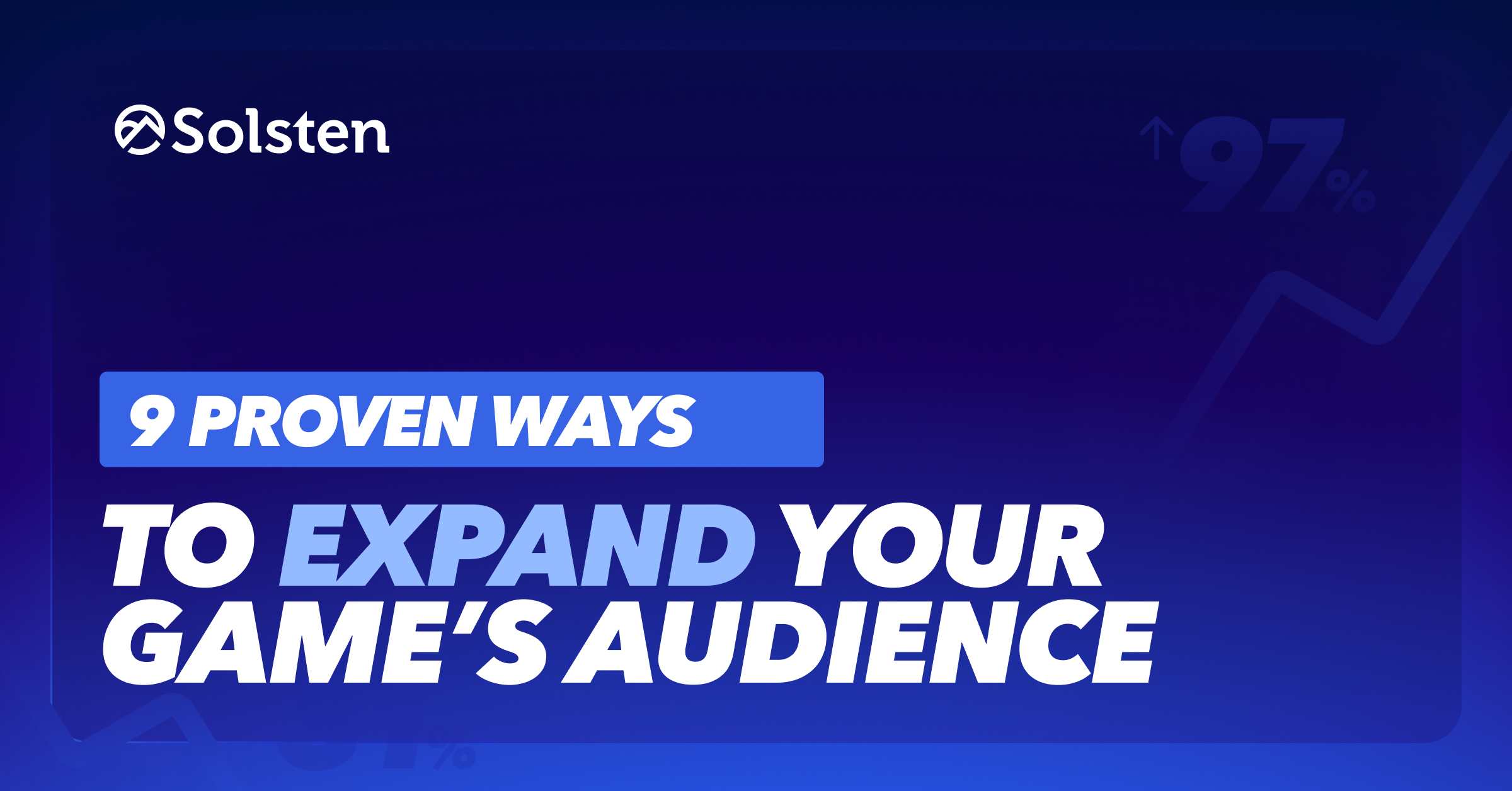Is it easier to expand your live game’s audience or build a new audience from ground up? At a time when audience attention is the most sought after commodity, you might assume that new always equals better. But the data shows us that is clearly not the case. Games that came out six or more years ago accounted for over 60% of the time players spent in games in 2023. That means that every new title released last year was fighting over 40% of the play time.
In this reality, studios are coming around to the fact that it makes economic sense to build on an existing audience rather than start a new one. But how do you attract more players in a market that’s saturated with countless options?
This article will outline nine proven strategies that can help you broaden your game’s reach and appeal. From integrating with streaming platforms to utilizing psychological insights and optimizing your marketing efforts, each method offers unique advantages and potential outcomes. We’ll also detail the advantages, difficulty level, and expected outcomes of each strategy. Read on to discover how you can enhance your game’s visibility, engage with new audience segments, and make your game a continued success.
Integrate With Streaming Platforms
Streaming platforms like Twitch and YouTube are the ultimate word of mouth channels for gaming. They’re a central hub for gaming communities, offering unparalleled exposure to highly-engaged audiences. At any given time, Twitch has over two million concurrent viewers. By integrating your game with these platforms, you tap into a massive pool of potential players who are actively seeking new gaming content.
What do these integrations look like in practice? They can take several forms, including API integrations, streamer partnerships, and features that let streamers easily broadcast and share your game content with their audiences.
These integrations create opportunities for streamers to naturally promote and showcase your game. This exposure can lead to increased visibility, organic growth, and a stronger community around your game. As viewers discover your game through their favorite streamers, they are more likely to try it and become active players themselves.
Advantages: Massive, engaged audiences; high visibility; potential for viral growth.
Difficulty: Moderate. Requires technical integration and presents content moderation challenges.
Success: Increased viewership, follower growth, and game downloads from platform traffic.
Develop a Data-Driven Persona Strategy
Creating scientifically-derived player personas allows you to deeply understand your most valuable audience segments. By analyzing demographic, motivational, and psychographic data, you can make targeted marketing campaigns and in-game experiences that resonate with each persona’s specific desires and motivations. This personalized approach leads to higher conversion rates, increased player satisfaction, and improved retention. A data-driven persona strategy also helps you make informed decisions about game design, content updates, and future development.
Advantages: Targeted, effective marketing and in-game experiences; improved player understanding.
Difficulty: High. Requires extensive data collection, analysis, and persona development.
Success: Higher conversion rates, player satisfaction, and retention.
Use Psychological Audience Insights to Identify and Target Similar Player Segments
Understanding the psychology of your player base gives you the power to target potential players who your experience is more likely to resonate with. By analyzing factors like motivations and preferences, you can understand why your high-value audiences are playing your game. Targeting these segments with motivation-based marketing messages and tailored game experiences can lead to increased player acquisition, retention, and overall game success.
Advantages: Ability to identify and engage high-value, likely to engage audiences.
Difficulty: High. Requires in-depth research and data analysis.
Success: Increased player acquisition and retention from targeted segments.
Use Affinity Data to Identify Strategic Partnerships and Influencer Collaborations
Affinity data helps you identify the brands, IP, and interests that your target audience has a strong connection with. By forming strategic partnerships and collaborations with these entities, you can expose your game to new, high-potential audiences who are likely to be interested in your offering. These partnerships lend credibility to your brand and create opportunities for cross-promotion, leading to increased awareness, game downloads, and player engagement.
Advantages: Exposure to high-potential audiences; enhanced brand credibility.
Difficulty: Moderate. Requires affinity data analysis and partnership management.
Success: Increased brand awareness, game downloads, and player engagement.
Collaborate With Influencers in Adjacent Niches
Influencers give you a directly line of communication to entirely new, highly-relevant audiences. These influencers have built trust and credibility with their followers, and their endorsement can lend legitimacy to your game. Working with influencers in adjacent niches involves partnering with content creators and public figures who have a strong following in areas related to your game’s theme or setting. These influencers may not be directly focused on gaming, but their audience shares common interests that align with your game. By working with these influencers, you can tap into new, relevant audiences and expand your reach beyond the core gaming community.
An example of this is when Assassin’s Creed Odyssey collaborated with history YouTuber Extra Credits to create videos exploring the historical context and accuracy of the game’s Ancient Greece setting.
When collaborating with influencers in adjacent niches, it’s essential to find genuine connections between your game and their area of expertise. The partnership should feel authentic and provide value to both the influencer’s audience and your game’s community.
Advantages: Access to new, relevant audiences; enhanced credibility and trust.
Difficulty: Moderate. Requires identifying the right influencers and creating mutually beneficial partnerships.
Success: Increased exposure, downloads, and player engagement from influencer promotions.
Analyze Player Behavior to Inform Game Development
Continuously monitoring and analyzing player behavior within your game provides insights into player preferences, engagement patterns, and areas for improvement. This data helps you make informed decisions about game updates, new features, and content that align with player interests.
This approach is even better when paired with psychological player insights. Behavioral data will only tell you what your players do. Psychological data tells you why they do it. Combining the two helps your game remain relevant, engaging, and enjoyable for your audience, leading to increased player retention and long-term success.
Advantages: Game content aligned with player preferences; enhanced engagement and longevity.
Difficulty: High. Requires continuous data analysis and game updates.
Success: Increased player retention, satisfaction, and lifetime value.
Optimize Marketing by Focusing on High-Value Segments
Focusing your marketing on your most relevant and valuable audience segments allows you to maximize the impact of your campaigns while reducing unnecessary costs. By optimizing creative around the motivations of your high-potential player segments, you can allocate your marketing budget more effectively, targeting those most likely to engage with and spend money on your game. This optimization leads to lower CPIs, higher conversion rates, and increased ROAS.
Advantages: Maximized campaign impact; reduced costs; improved ROI.
Difficulty: Moderate. Requires audience segmentation and targeted campaign creation.
Success: Lower customer acquisition costs, higher conversion rates, and increased revenue.
Enhance Player Retention by Tailoring In-Game Experiences
Understanding the specific motivations and desires of your core audience segments lets you create personalized in-game experiences that keep players engaged and loyal. By tailoring content, rewards, and progression systems to meet the needs of different player profiles, you foster a sense of connection and value for each player. This approach leads to higher retention rates, increased player satisfaction, and greater in-game spending.
Advantages: Improved player engagement, loyalty, and lifetime value.
Difficulty: High. Requires deep player understanding and personalized content creation.
Success: Higher retention rates, player satisfaction, and in-game spending.
Monitor Shifts in Player Psychology and Market Trends
The gaming world is constantly changing, with new trends, technologies, and player preferences emerging rapidly. By monitoring shifts in the psychology of your player base, you can stay ahead of the competition and adapt your expansion strategy in real-time. This proactive approach lets you find new opportunities, address changing player needs, and maintain a competitive edge in the market, leading to long-term growth and success.
Advantages: Staying ahead of the competition; ability to adapt quickly to changes.
Difficulty: High. Requires ongoing research, data analysis, and strategy adjustment.
Success: Maintained competitive edge, increased market share, and long-term growth.
Conclusion
Each of these strategies will pay off in different ways, all with the goal of expanding the audience of your established game. However, some of them may be intimidating to undertake given their difficult nature.
It doesn’t have to be that way.
To take the difficulty rating from “high” to “low” for the most effective strategies outlined here, we’ve put together a step by step guide to expand your game’s audience for maximum growth potential. This guide will drive your expansion strategy with psychological player insights, reducing guesswork and enhancing the effectiveness of your marketing campaigns.



